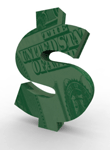 Let’s begin with a simple multiple choice question. What helps to improve cash flow? A. Reduce expenses; B. Increase sales volume; C. Improve inventory turnover; D. Raise maintained markup; E. Properly timed deliveries; Or, F. All of the above.
Let’s begin with a simple multiple choice question. What helps to improve cash flow? A. Reduce expenses; B. Increase sales volume; C. Improve inventory turnover; D. Raise maintained markup; E. Properly timed deliveries; Or, F. All of the above.
If you answered “F” congratulations, you are probably a savvy retailer. Cash is King in the retail business. Strong, positive cash flow is a must for any thriving retail establishment. The benefits of positive cash flow are numerous: pay vendors on time, take discounts, expand or remodel, add brands, pay yourself more, and so on. Poor cash flow, however, forces retailers to make survival decisions they may otherwise not make. This is what I commonly refer to as Management by Crisis.
Decisions made during periods of difficult cash flow might include not taking discounts, paying vendors late, paying COD for inventory, not taking entrepreneurial risks that might be good for the business, cutting back on essential services that keep a healthy business thriving, bank loans taken out when needed cash is sitting in boxes on the shelves, and running sales events out of panic in order to create cash.
Improving Cash Flow Has Multiple Steps
But cash flow can be improved, and here is how:
1) Reduce expenses:
Make sure that operating expenses are in line with industry norms. Set an operating expense budget based on current volume and stick with it. Two of the largest and most common areas that get out of line are occupancy and payroll costs. However, if you are continually borrowing money to finance a heavy inventory, you are probably paying unnecessary interest expenses.
2) Increase sales revenue:
More sales at the register mean more cash in the bank, assuming that the sales are being generated at normal margins. Excessive markdowns taken as a result of overbuying or other merchandising infractions are not considered a profitable way of generating sales. Effective use of off-price merchandise can be a vital component to driving volume.
3) Improve inventory turnover:
Reducing the average inventory and not buying more than you can profitably sell is essential to keeping cash flow positive. Understanding gross margin return on investment (GMROI), which blends average inventory and gross margin, would be very useful here.
4) Raise maintained markup:
Increasing maintained markup can be accomplished by either raising initial markup or by reducing markdowns. Since this is an average, not all stores need this high of a markup while others may need more. Good retailers maximize IMU wherever possible. This is the reward for diligent buying and good negotiating. In today’s retail environment, all retailers need to strategically avail themselves to opportunistic pricing (buying off-price) whenever possible in order to maximize maintained markup.
5) Properly timed deliveries:
The timing of merchandise deliveries is critical to the optimization of cash flow. This point is closely linked with all of the points previously covered. What sells fastest in your store, the new merchandise that arrived just ahead of the new season or last season’s leftovers that you couldn’t even get rid of on sale? If vendor terms aren’t prearranged, some stores end up paying for goods months before they have had an opportunity to sell them in some cases. I have also seen examples of stock levels in seasonal categories (i.e. sandals or winter footwear) that are actually higher in the months following the season than they were during the season due to accepting late deliveries.
Since inventory is most-often a retailer’s single largest asset, more time and resources should be devoted to monitoring this area. Accurate sales and inventory forecasting is essential in order to maintain and strengthen cash flow. Inventory related costs can take over half of a retailer’s annual budget and operating expenses eat up another 40 percent on average. In other words, $0.96 of every dollar is committed to merchandise and expenses when things are running normally. When the items above are the least bit out of sync, cash flow begins to erode. Most prudent people wouldn’t think of not having insurance on their home or car for peace of mind and protection. Think of a comprehensive merchandise plan coupled with a cash flow plan as an insurance policy for your largest asset, your inventory.
To learn more on merchandising, inventory and cash flow check out our Management Section.
Ritchie Sayner is Vice President of Business Development for RMSA Retail Solutions.
